Hisense S7NQ Canvas TV is a very interesting option, especially for those who are looking for something in the style of a picture-TV but don't want to spend a fortune. At first glance, it stands out primarily because the gallery mode with artwork is completely free – there’s no subscription fee, unlike Samsung's The Frame. Moreover, the box includes a light brown frame right away, which will be an extra bonus and saving for many people. Although it is primarily a TV for displaying art, it surprisingly performs quite well in other applications as well. The 144 Hz panel, full HDMI 2.1, support for VRR and ALLM – all of this makes gaming on consoles entirely possible and quite enjoyable. The Vidaa system runs smoothly, and we find all the most important apps and features here, such as AirPlay, USB recording, or screen mirroring from your phone. But there are also things that fall a bit short. First and foremost – the actual images. Compared to The Frame from Samsung, they simply look more digital here. There's a lack of that depth, paint texture, and subtle details that really impress with the competitor. Even though at first glance we’re dealing with a similar, matte panel, in practice, it performs much worse at suppressing reflections. Colours and blacks fade much quicker, especially in a bright room. This could also be the effect of lower brightness – Hisense is simply darker than its Korean rival. Additionally, there are some minor software flaws – e.g., the lack of displaying external subtitles despite the option to configure them, or the not entirely effective image smoothing function with lower quality materials. In short: the S7NQ is a good TV in the form of a "picture" that can be a great alternative for those who don’t mind the lower quality of displayed artworks but value the absence of subscription fees, an extra frame in the package, and the full functionality of a typical TV. It's not an ideal product, but a reasonable compromise for Samsung The Frame.
- Matching (Score)
- Our verdict
- TV appearance
- Where to buy
- Contrast and black detail
- HDR effect quality
- Factory color reproduction
- Color reproduction after calibration
- Smoothness of tonal transitions
- Image scaling and smoothness of tonal transitions
- Blur and motion smoothness
- Console compatibility and gaming features
- Input lag
- Compatibility with PC
- Viewing angles
- TV efficiency during daytime
- Details about the matrix
- TV features
- Apps
- Playing files from USB
- Sound
Hisense S7NQ CanvasTV vs TCL C6K
Direct compare
S7NQ / CanvasTV
C6K / C69K / Q6C
Available screen sizes: 55”


Panel type: LCD VA
Resolution: 3840x2160
System: VIDAA
Model year: 2024
Complete the survey to find out the result

Panel type: LCD VA
Resolution: 3840x2160
System: Google TV
Model year: 2025
Complete the survey to find out the result

Overall rating
6.7
7.1
Movies and series in UHD quality
6.6
6.7
Classic TV, YouTube
6.3
6.6
Sports broadcasts (TV and apps)
6.1
6.3
Gaming on console
7.5
8.4
TV as a computer monitor
7.0
8.6
Watching in bright light
5.4
6.4
Utility functions
9.0
7.0
Apps
7.7
9.6
Sound quality
6.3
6.5
Complete the survey to find out what fits your preferences
Advantages
Free gallery without subscription
Frame included
Great for gamers (144 Hz, HDMI 2.1, VRR, ALLM, Game Bar)
Supports Dolby Vision, HDR10 and HDR10+
Decent native contrast (VA Panel)
Works well with PC (chroma 4:4:4)
Fast Vidaa System
Straightforward connection to home theatres: Supports Dolby and DTS codecs
Very good contrast and black levels: VA panel and MINI-LED backlighting
Good motion smoothness: High refresh rate of 144Hz
Decent panel brightness
Many features for gamers: VRR, ALLM, HDMI 2.1, HGiG
Additional mode for PC gamers: 240Hz
GoogleTV system with a wide selection of apps
Support for multiple HDR formats including Dolby Vision
Support for Dolby Atmos and DTS
Very attractive price
Disadvantages
Worse image quality in gallery mode than in Samsung The Frame
Colours and blacks fade significantly in bright environments
Missing HGiG mode (for gamers)
Software issues - external subtitles do not display in films
Management of the backlighting could be better
Language errors in the system
Our verdict
TCL C6K is a TV for those who want to combine gaming and watching movies with good contrast, all without breaking the bank. With its VA panel illuminated by Mini-LED, blacks are deep and contrast is high, making evening viewings look truly impressive. Additionally, it boasts decent brightness, which paired with Dolby Vision gives films a cinematic quality. Importantly, the smoothness of the image – the 144Hz refresh rate works wonders for sports and dynamic games, and gamers receive a full package of bonuses: VRR, ALLM, HDMI 2.1, HGiG, and even a 240Hz mode in PC. For daily use, the TV is powered by Google TV, which offers a multitude of apps and the Gemini AI voice assistant, making navigation convenient and flexible. It's also worth mentioning the sound – support for Dolby Atmos and DTS gives the impression that the device is ready not just for gaming. As is often the case, there are a few things that could be improved. The backlighting in challenging scenes can lose details or wash out blacks, and the Polish translations in the menu can be so clumsy that you really have to think about what’s being said. Despite this, the overall package holds up very well, and considering the price, the TCL C6K could be one of the more interesting choices for anyone looking for a versatile TV for movies, sports, and gaming. Especially when a good promotion comes along – and when TCL traditionally fine-tunes the details in updates.
TV appearance




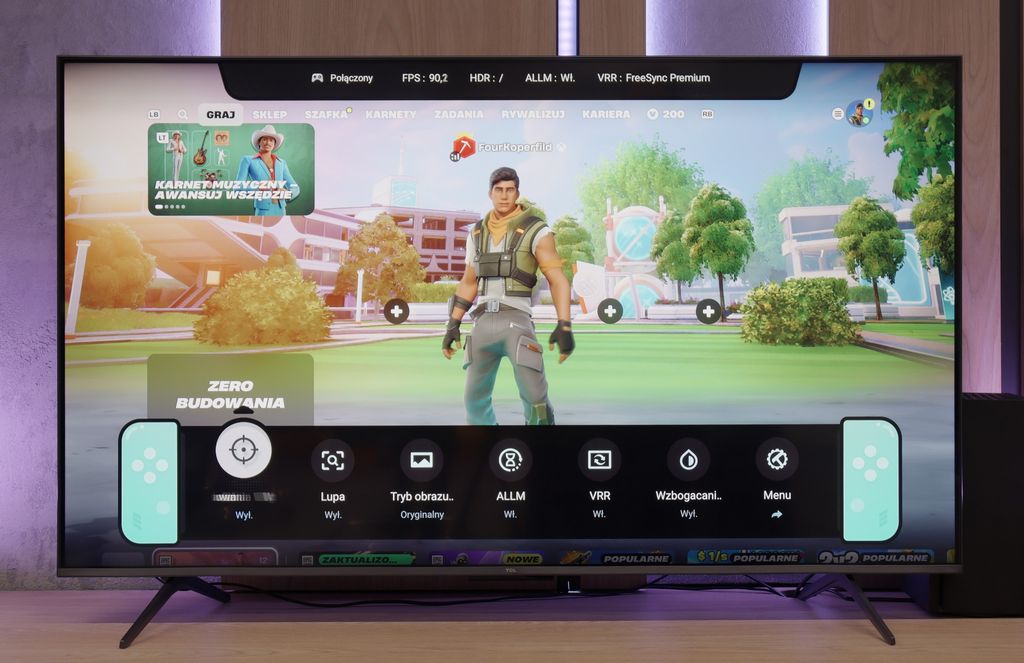
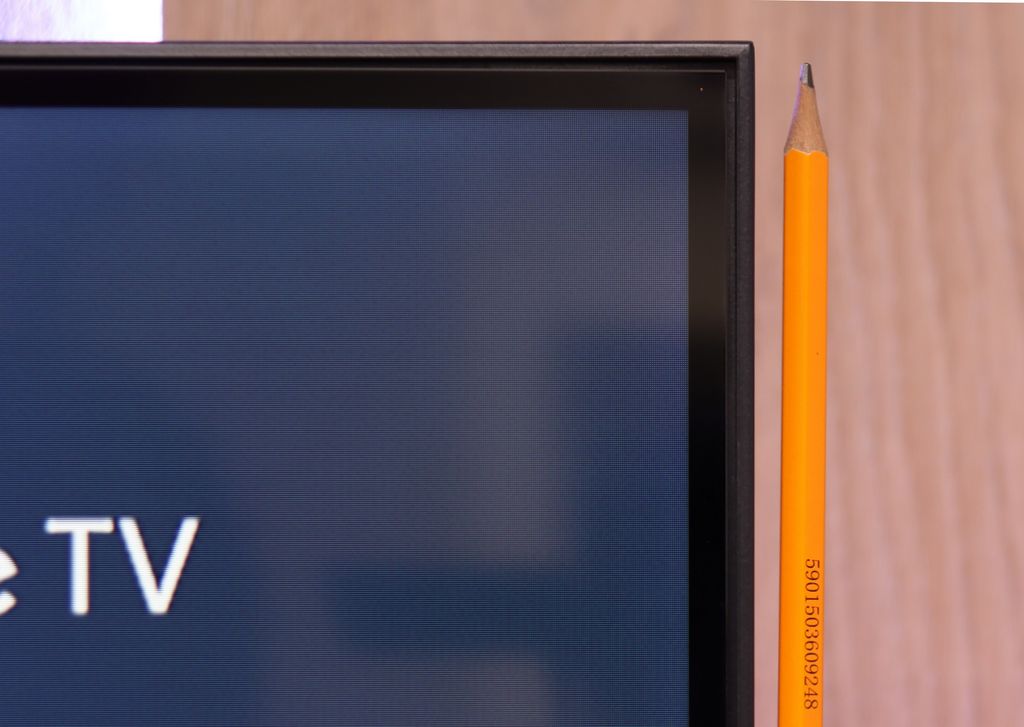
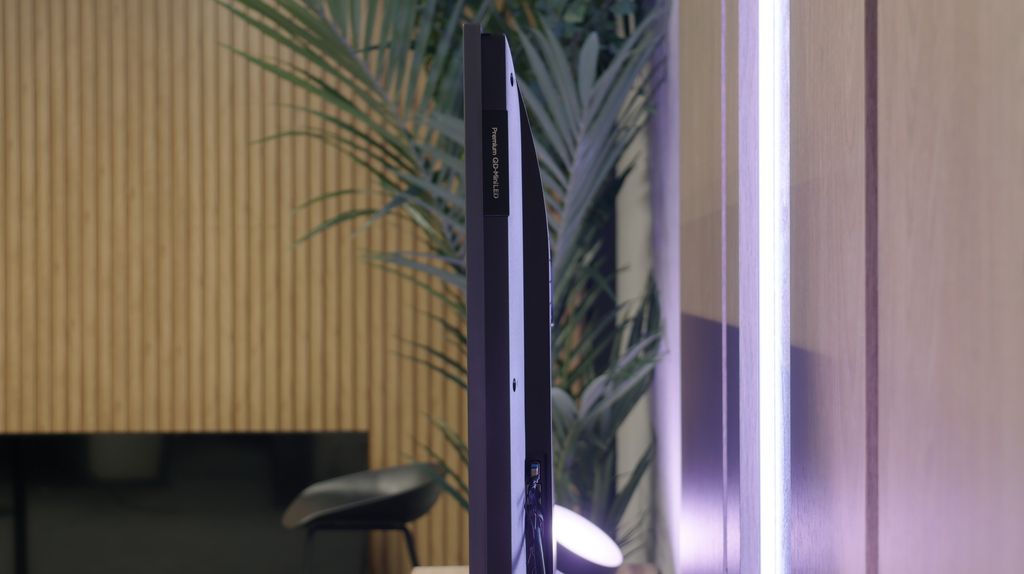
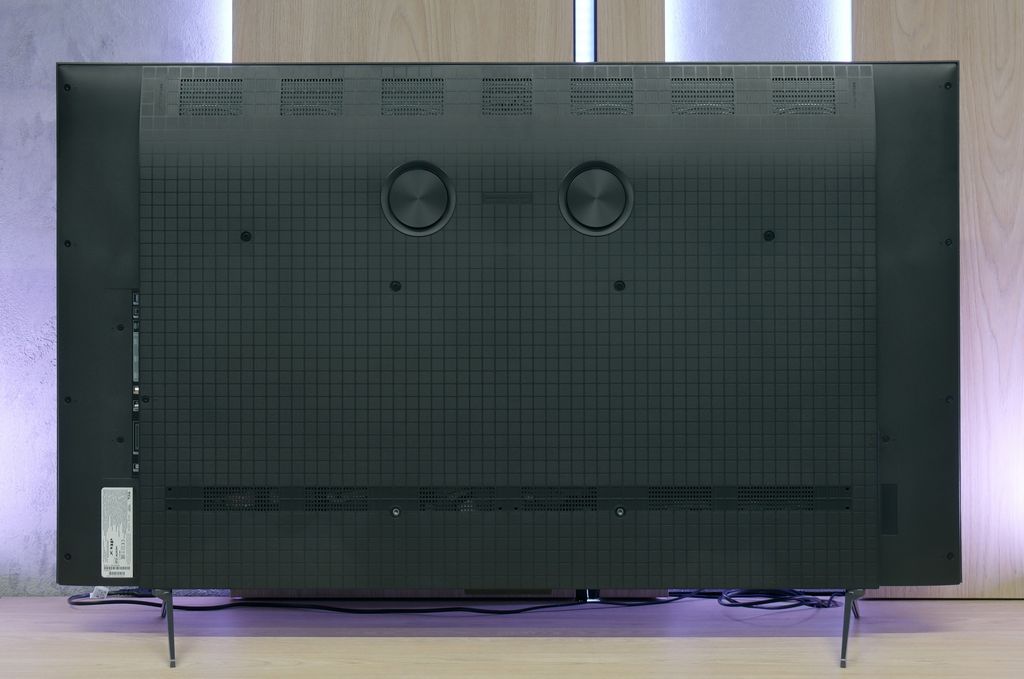
Contrast and black detail
5.6/10
7.3/10
Local dimming function: No
Local dimming function: Yes, number of zones: 180 (10 x 18)
Contrast:

Result
3,400:1

Result
4,200:1

Result
5,200:1

Result
5,050:1

Result
3,650:1

Result
114,000:1

Result
17,300:1

Result
16,200:1

Result
9,900:1

Result
4,850:1
Halo effect and black detail visibility:

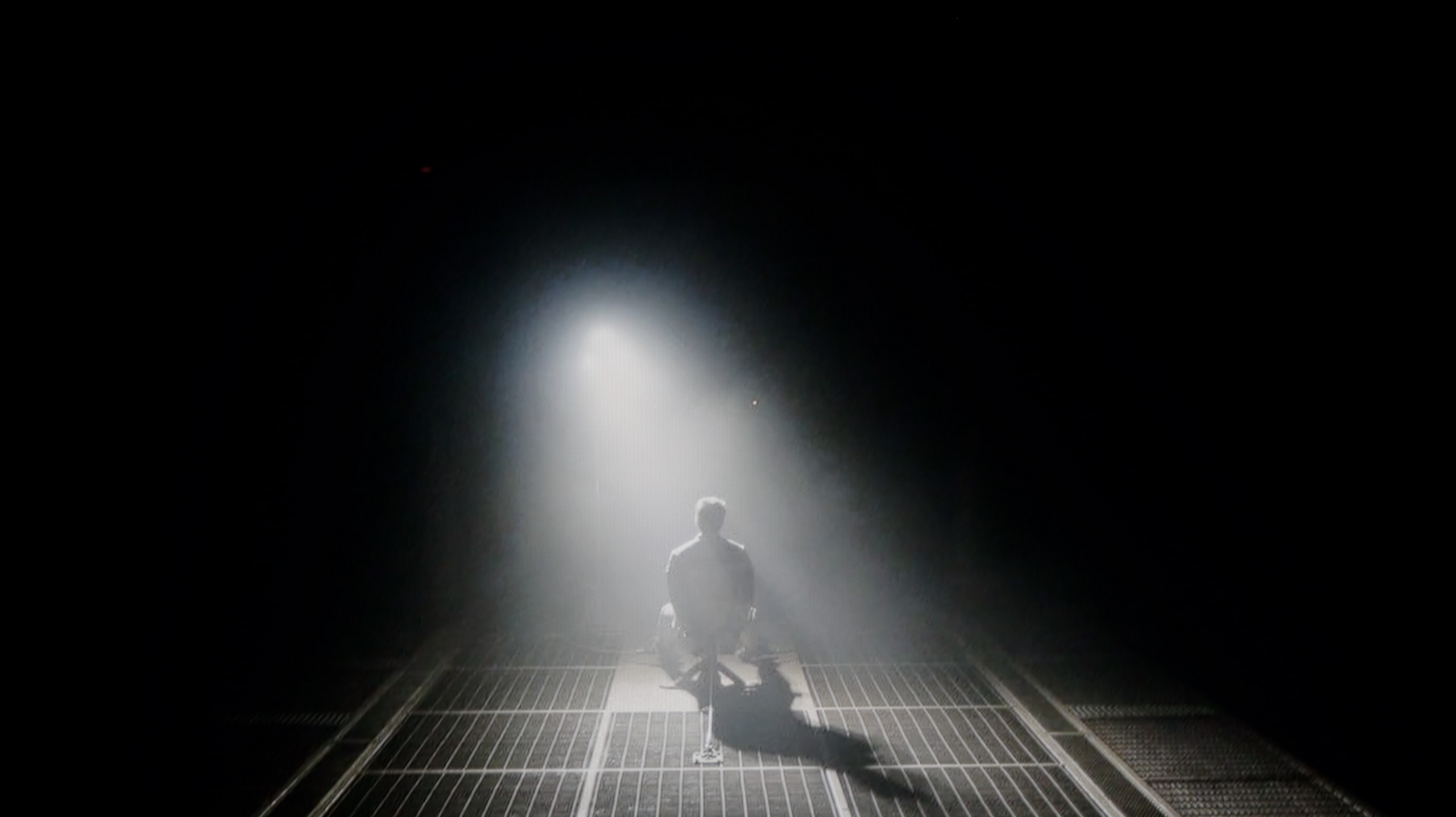
The Hisense S7NQ CanvasTV is a television equipped with a VA panel, which on its own provides decent contrast. Our test patterns confirm this – an average score of around 4000:1. It may not be an outstanding value, but for this class of device, it's quite decent. Perhaps the result would be significantly better if the television was equipped with local dimming technology; however, this model sadly lacks that feature. As a result, blacks in a completely dark room resemble shades of navy blue or grey more than true black. This situation causes a slightly noticeable clouding effect. Overall, it's okay, but without any real excitement.
The TCL C6K is based on a VA panel, specifically an HVA produced by TCL CSOT, which already delivers a solid native contrast of 6000–7000:1 without the use of local dimming. However, the true strength of this model lies in its Mini-LED backlighting with the ability to dim individual zones. In the tested 55-inch version, we counted around 180 zones, and as the diagonal size increases, this number naturally grows. For a television in this price segment, the contrast is truly impressive. In simpler film scenes, such as segments from 'Oblivion', it looks fantastic, and shots completely filled with black make a great impression. Of course, due to the characteristics of Mini-LED technology, it's not always possible to avoid issues – in more challenging frames with many bright details, halo effects can appear, or some elements may be dimmed too strongly (regardless of local dimming settings). Nevertheless, the contrast can be regarded as a strong point of the C6K.
HDR effect quality
5.6/10
4.9/10
Luminance measurements in HDR:

Result
455 nit

Result
414 nit

Result
438 nit

Result
451 nit

Result
470 nit

Result
612 nit

Result
202 nit

Result
424 nit

Result
144 nit

Result
587 nit
Scene from the movie “Pan” (about 2800 nits)


Scene from the movie “Billy Lynn” (about 1100 nits)


Static HDR10


Dynamic: Dolby Vision
Dynamic: Dolby Vision


HDR luminance chart:
TCL C6K
Luminancja HDR
Luminance of RGB colors
Hisense S7NQ CanvasTV
Luminancja HDR
Luminance of RGB colors
When it comes to the brightness of the television and how it handles bright elements while watching films, it's just average – similar to the contrast. The average brightness level of the Hisense S7NQ is around 500 nits. This is a value that allows you to feel the hints of true HDR, but it's definitely not enough to speak of remarkable effects. However, the television should be praised for its colour gamut coverage – films look very colourful and vibrant. Thanks to the use of a PFS LED (QLED) coating, the device is able to cover more than 90% of the DCI-P3 colour gamut and over 72% of the wider BT.2020 palette. For a television of this class – these are really very good results.
TCL C6K is a moderately bright television that can showcase its full capabilities in the best movie conditions – the maximum brightness is around 600 nits. In scenes with large, intense light sources, the HDR effect can be truly satisfying, providing a sense of cinematic sparkle. However, it's important to remember that with local dimming management, there are situations where some elements become dimmed, and sometimes even barely visible. It is clear that there is a lack of proper optimization of the algorithms, although looking at the technical parameters in this price range, the build quality performs very well.
Factory color reproduction
7.2/10
5/10


Factory Mode
After calibration


Factory Mode
After calibration
Let's check how the Hisense S7NQ CanvasTV performs in terms of colour reproduction in its best factory mode, which is Filmmaker. Right from the start, it’s clear that it’s definitely better than in dynamic or standard mode, but there are still a few things to nitpick. In terms of image quality from HD signals, the colours are slightly skewed – there’s a dominance of cooler blue tones and a lack of red. This makes the image seem a bit too cool.
A similar effect is noticeable in 4K content, but it’s more pronounced there. The excessive exposure of blue tones and lack of red makes the image appear distinctly cold. However, the biggest issue with this TV isn’t the colours themselves but the way brightness is managed. The unit we tested slightly increased brightness compared to the reference value. The result of this is indeed better visibility of details, but at the cost of significantly lighter blacks – which makes the entire image seem more "flat."
A similar phenomenon was observed in the 4K signal – the slightly inflated curve at the beginning of the EOTF graph indicates that the TV has a tendency to overexpose certain scenes. Fortunately, this effect can be improved through professional calibration, which we will discuss in the next point.
This year's TCL televisions have introduced the Filmmaker mode, and it must be said that it is definitely the best choice right out of the box. This is the mode we recommend for everyday viewing of movies and series. Unfortunately, as is often the case, the best does not mean perfect. In the case of SDR content, the image was too warm, as the red was quite prominent in the white balance. On the other hand, with HDR content, we had the opposite impression – the image became cooler than it should have been, due to an excess of blue. There is also the brightness characteristic, which at times led to overexposure. In practice, these issues combined resulted in quite noticeable errors in colour tests, which are hard to accept in a mode advertised as “by the creators”.
Color reproduction after calibration
8.3/10
7.5/10




The results we achieved after calibrating the Hisense S7NQ are really very good. Thanks to the calibration, we managed to eliminate excessive blue tone exposure and deficiencies in red with HD signals. A similar, albeit slightly weaker effect was also achieved with 4K HDR content. Brightness management in HD materials has also improved – the television no longer struggles with brightening the image "overall".
However, there are things that cannot be circumvented. The character of the EOTF curve has hardly changed, and the lack of local dimming means that the smallest elements on the screen will always be slightly overexposed. You just have to come to terms with this when choosing a television with a similar type of backlighting. Nevertheless, the final effect is very good and should fully satisfy the vast majority of users.
Thanks to the white balance adjustment, we were able to significantly reduce the C6K's tendency to distort colours, which resulted in a very good end result. After calibration, we won't observe the effect of excessive warming of scenes in SDR or overly cooling the image in HDR. However, it is worth taking a closer look at the brightness characteristics. In SDR content, it's hard to have major objections – the picture looks really good, especially in older movies, TV shows, or material from YouTube. It performs significantly worse with HDR content. An analysis of the EOTF curve suggests that everything is fine, but in practice (EOTF in movies), the limitations of the construction become apparent. The television tends to excessively brighten the smallest fragments of the frame, and in other situations, it can overly dim the entire scene. The effect of calibration is therefore noticeable, and regarding colourimetry, the C6K has really gained a lot, but certain limitations resulting from local dimming and actually from its management by the C6K simply cannot be overlooked.
Smoothness of tonal transitions
9.2/10
9.5/10












The fluidity of tonal transitions is one of those categories that even less advanced users can notice. If someone doesn’t know what this means – we’ll explain. It’s about whether the colours blend smoothly into each other or if their “sticking” is visible in the form of distinct bands. Good tonal transitions are those that are natural and smooth, without significant jumps in colour.
The Hisense S7NQ performs very well in this area, although it must be honestly admitted that it falls slightly short compared to Samsung The Frame. In very bright scenes, slight imperfections can be noticed, but you really need a trained eye to catch them. Overall – as with most “frame” style televisions – it still performs excellently.
The transitions between colours in the C6K are very smooth, and it’s hard to nitpick any banding. The image looks natural, and any minor imperfections can only be noticed on bright test patterns – and only with really careful viewing. In everyday use, the effect is simply fantastic, and it’s safe to say that in this category, the C6K performs outstandingly.
Image scaling and smoothness of tonal transitions
5.5/10
5/10
Smooth transition function


Image without overscan on the SD signal


Equally important is how the television handles tonal transitions with a poorer signal – for example, in older films, on television, or on YouTube. Unfortunately, despite the presence of the “Smooth and Gradient Picture” feature, which was supposedly meant to improve this aspect, its functionality is really poor. It’s barely noticeable that it has any real impact on the visibility of colour transitions.
The image scaling is also disappointing. Yes, you can see that the television is trying to “pull up” the quality, but the end result is far from ideal. The image often appears slightly jagged, which is particularly noticeable in the example of tree branches in the background. Additionally, the Hisense S7NQ has a clear tendency to crop the image at lower resolutions, which could result in missing subtitles in the news or finer details in the image.
TCL C6K performs quite well in terms of upscaling. Lower quality materials appear acceptable, and the absence of overscan issues means the image is displayed in full, without cropping. However, one cannot expect miracles – very low quality content won't come to life here, as the image processor has its limitations. On thin lines or details, there is characteristic tearing visible, which indicates a lack of advanced image enhancement algorithms. It is also a shame that the C6K lacks the function of smoothing tonal transitions – in older films or video materials, colour banding can be noticeable and may be distracting during longer viewing sessions.
Blur and motion smoothness
6.5/10
7.3/10

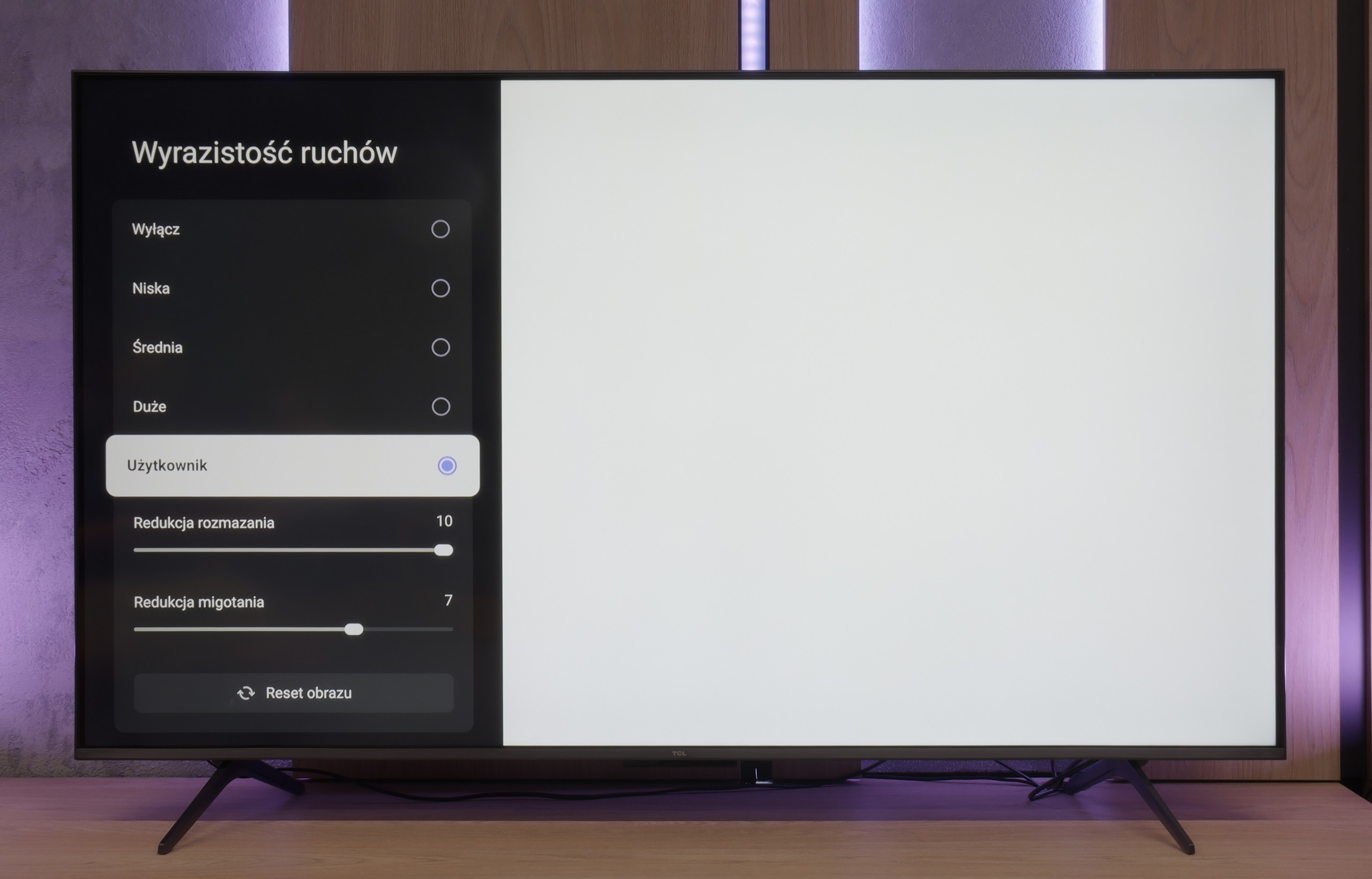
Blur (native resolution, maximum refresh rate):






Blur (BFI function enabled):



When it comes to motion fluidity, the television performs really well. Although the S7NQ was primarily designed for displaying static elements – such as images – the manufacturer has used a panel with a refresh rate of 144 Hz. As a result, sports or games look really good on it.
For content that is not recorded at a high frame rate, the manufacturer has provided two features that allow you to adjust the picture to your own preferences. “Motion blur reduction” and “blur” operate on a 10-point scale, enabling a choice between a more cinematic image – with characteristic frame jumps – and a smooth effect reminiscent of a “soap opera.” How to set this up? That’s a personal choice – we leave the decision to you.
TCL C6K uses a 144 Hz panel, which is a significant advantage in this price range. It's an important step forward in comparison to the previous model C655 PRO, which only offered 60 Hz in 4K. The difference is especially noticeable when watching sports or playing games – the ball, players, or fast action in the game are displayed more clearly and without losing detail. An interesting fact is the panel's ability to operate at 240 Hz, which the manufacturer doesn't mention in official materials. We will return to this topic when discussing the PC gaming mode.
TCL has also added a feature for movie watchers: "Motion Clarity," which allows users to adjust the image according to their preferences with two simple sliders. You can either keep the visible film frame or opt for a very smooth, almost theatrical effect. This way, everyone can find settings that match their taste.
Console compatibility and gaming features
8.5/10
9.8/10
- ALLM
- VRR
- VRR range48 - 144Hz48 - 240Hz
- Dolby Vision Game Mode
- Correct implementation of HGIG
- 1080p@120Hz
- 1440p@120Hz
- 4K@120Hz
- Game bar

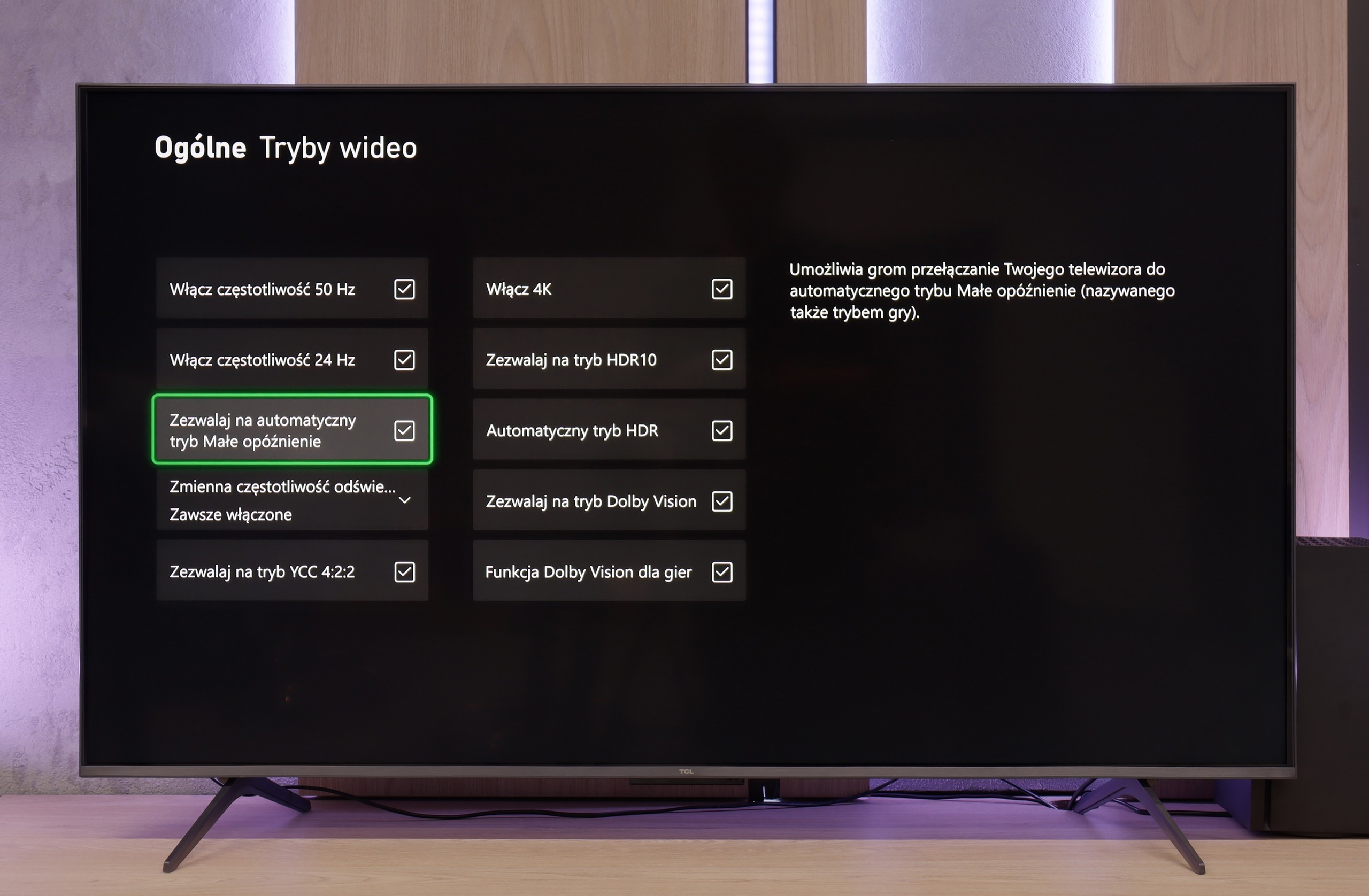

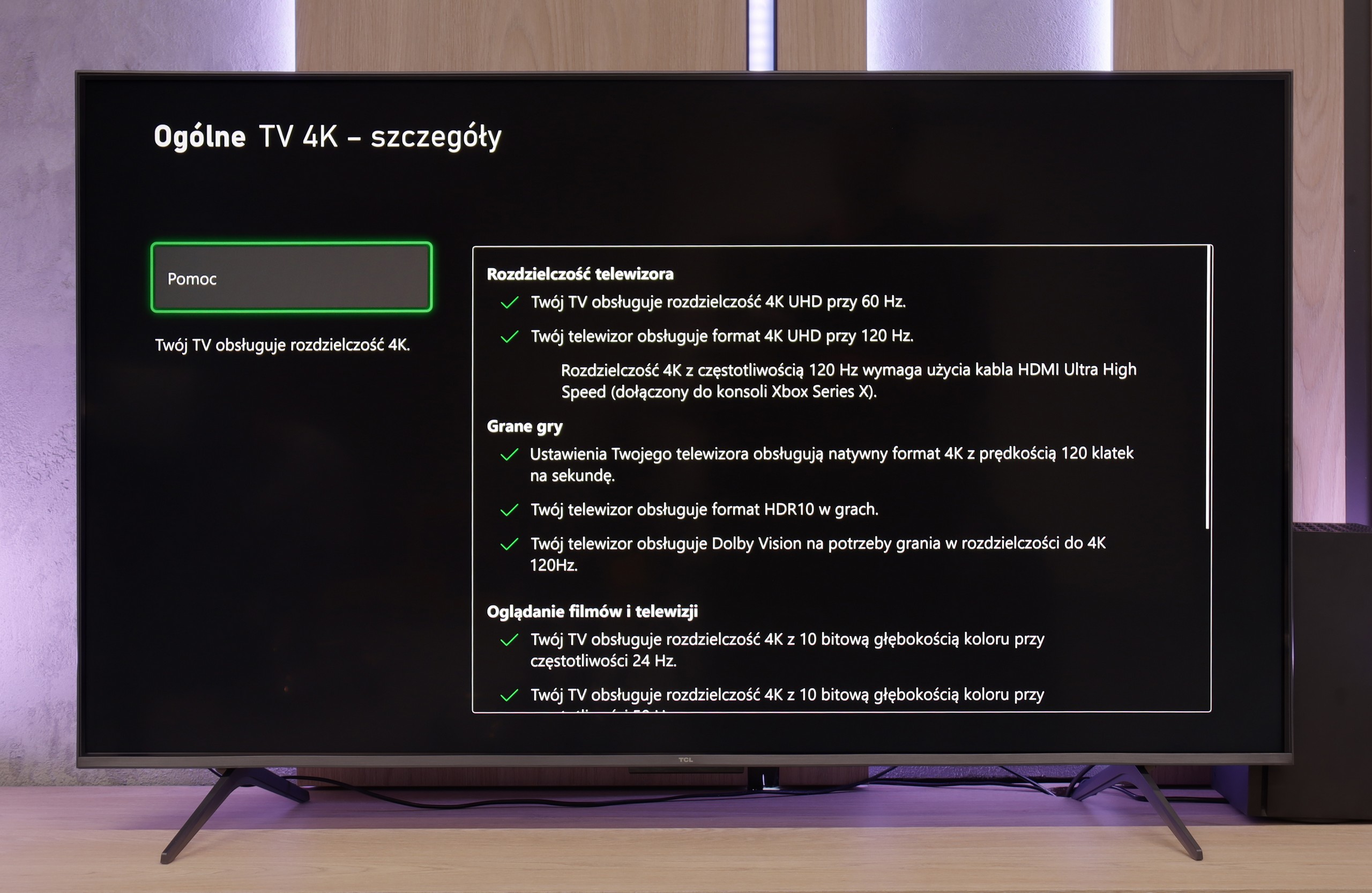

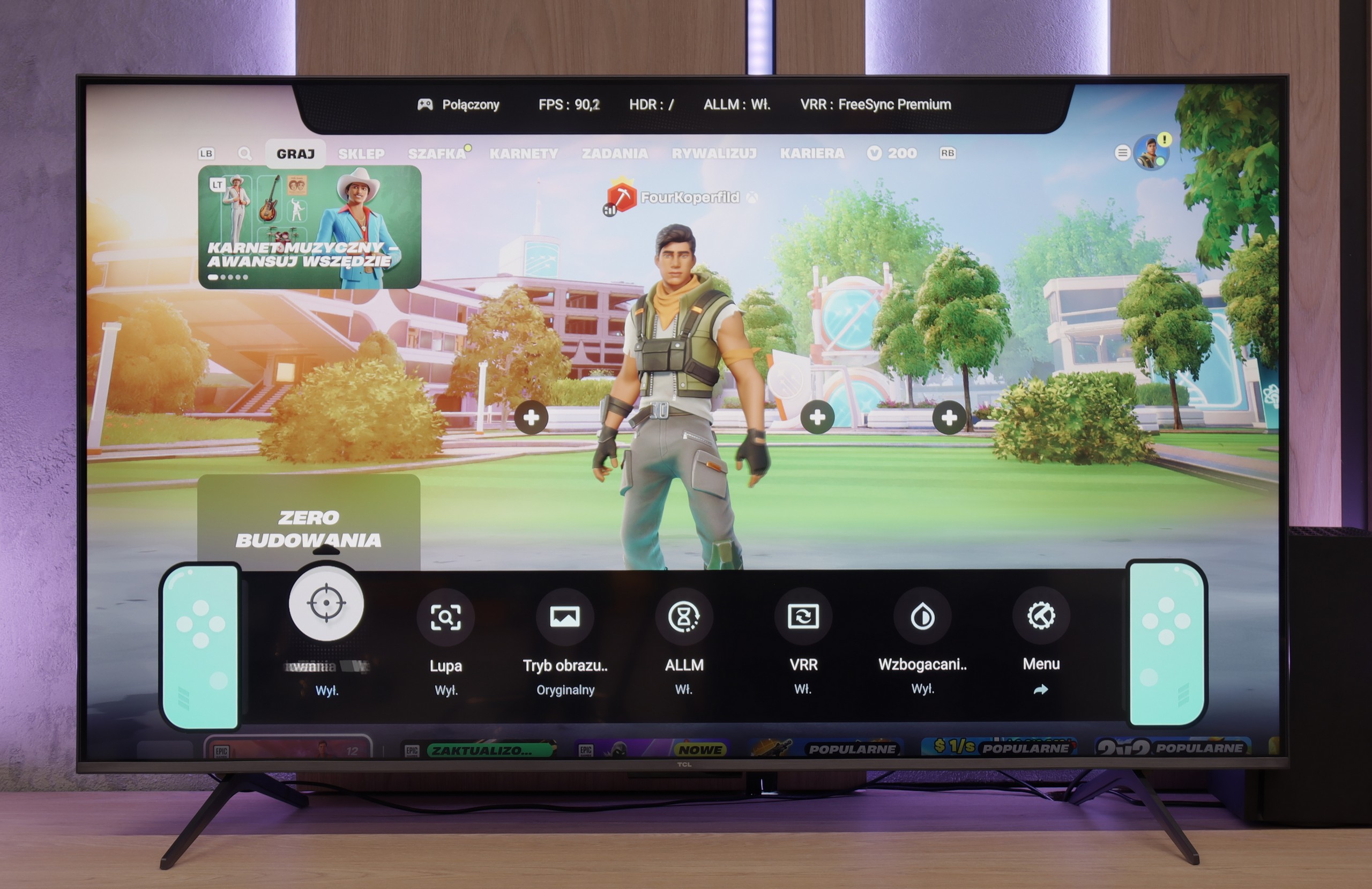


Even though the S7NQ is an "image" type television, you can actually play games on it. Really. It has practically everything (except for HGiG mode) that a modern gaming television needs. The 144 Hz panel and two full HDMI 2.1 ports allow for seamless connection of two consoles, such as the PlayStation 5 or Xbox Series X/S.
The television supports Automatic Low Latency Mode (ALLM) and Variable Refresh Rate (VRR) without any stutters or issues. It also handles high frame rates at lower resolutions without any trouble. A shoutout to Hisense for the very attractive Game Bar – it displays all available image options, and additionally, we have the ability to enlarge the minimap or turn on the crosshair (because sometimes someone might actually want to "aim" 😉).
The only missing element – as we mentioned earlier – is the lack of proper implementation of HGiG mode. This is the feature responsible for automatically setting the image in games as the developers intended. It’s a shame because it's the only thing that separates the Hisense S7NQ from being a full-fledged gaming "monster".
The TCL C6K is a television that can confidently be called equipment designed for gamers. We have 4K at 144 Hz, VRR support, an automatic gaming mode (ALLM), and Dolby Vision Gaming. On top of that, there's a practical Game Bar, which is a panel with the most important settings handy – useful when we want to quickly change something during gameplay (e.g. screen ratio: Yes, you can!). Notably, it has a wide range of VRR, reaching up to 240 Hz. However, this option is mainly for PC gamers who drop below the native 4K resolution. In that case, the television can spread its wings and show additional smoothness, especially in fast e-sport titles. For consoles, we stick with the classic limit of 120 Hz, but the possibilities are still quite broad. The only slight drawback is some minor motion blur that can occasionally be seen in dynamic scenes. Other than that, the C6K offers everything gamers expect from a television.
Input lag
8.7/10
9.7/10
SDR
HDR
Dolby Vision
Input lag in the Hisense S7NQ performs well, though it can't be said to be exceptional – especially for the standards of 2024/25. Values around 30–20 ms aren't very high and the average player likely won't notice it, but those who spend a lot of time gaming may feel a bit of discomfort.
The situation looks significantly better when playing in Dolby Vision mode – then the lag is lower and the gameplay feels more enjoyable. The problem is that there are still very few games supporting this mode and they are mainly available on the Xbox console.
In terms of input lag, the TCL C6K performs excellently. With 120 Hz content, the delay is around 10 ms, and at times even less. This is at a level where the response is practically instantaneous, and it’s hard to find any complaints. For 60 Hz materials, the result is around 18 ms – still a very good result, more than adequate for comfortable gaming.
Compatibility with PC
7/10
8.6/10

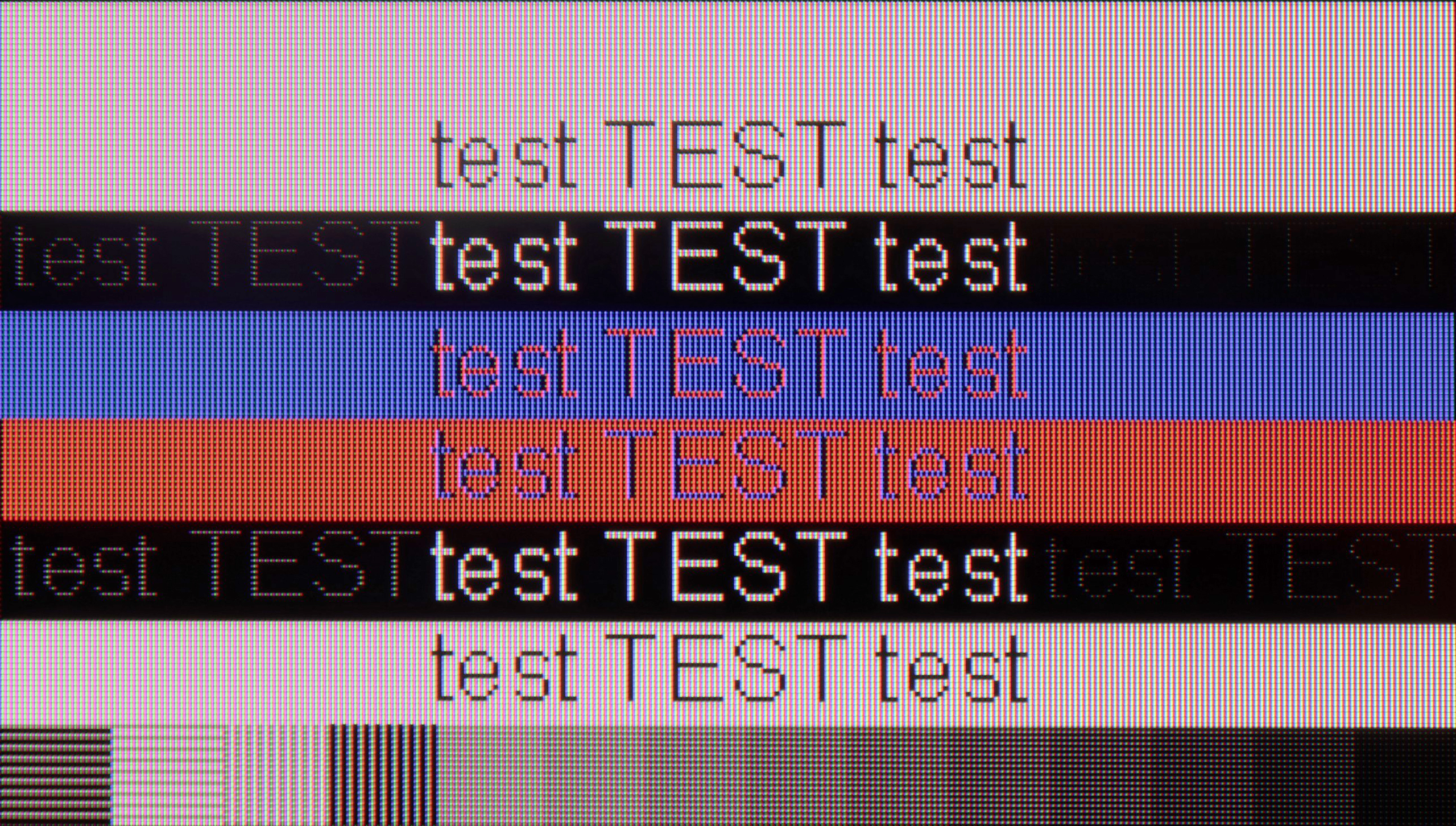
When it comes to working with a computer, the S7NQ Canvas TV performs really well. Gaming on it is smooth thanks to the presence of a 144 Hz panel and support for G-Sync with Nvidia cards. Input lag – as we mentioned earlier – is good, though not exceptional.
And how about productivity? It’s doable. The TV has a proper implementation of chroma 4:4:4, so fonts look quite sharp. You might nitpick about some minor issues with the thinnest letters on a dark background, but let’s be honest – rarely does anyone sit a metre away from a 55-inch screen reading small text.
After connecting the TCL C6K to the computer, it performs excellently. At native resolution, we have 4K at 144 Hz, and if we lower the resolution, we can even achieve 240 Hz. Additionally, the TV works well with Nvidia and AMD cards – it supports both G-Sync and FreeSync. It’s also hard to fault for office work. Fonts are sharp and readable thanks to 4:4:4 chroma support, and any minor imperfections are so negligible that they're simply not noticeable in regular use.
Viewing angles
3.4/10
3/10
Viewing angles here are typical for a VA panel. The S7NQ loses quite a bit when viewed from about a 45-degree angle – colours wash out and brightness noticeably decreases. It's a shame, as after all, it's a television that's meant to display works of art – it would be nice to be able to look at them from different spots in the room, not just straight on.
In the TCL C6K, the viewing angles are typical for VA panels. Sitting directly in front, the picture looks very good, but any movement to the side results in a noticeable drop in colour saturation and brightness. The difference is particularly evident in colourful scenes – the hues become washed out, and the contrast loses its depth. Compared to IPS panels, this is clearly a weaker result, although the better black levels and higher native contrast remain a compensating factor – "you win some, you lose some".
TV efficiency during daytime
5.4/10
6.4/10

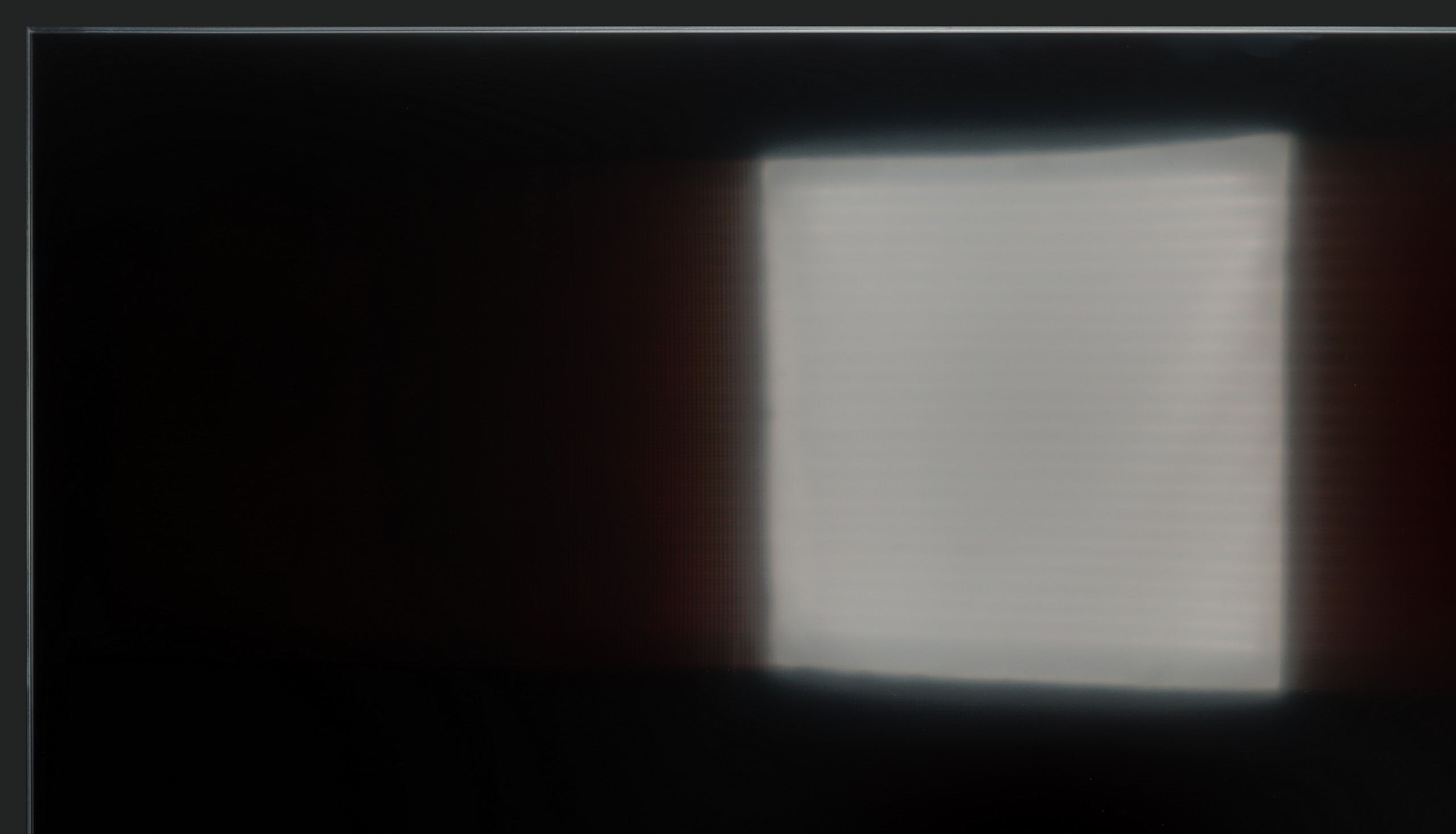


Matrix brightness
Average luminance SDR
TCL C6K: 532 cd/m2
Hisense S7NQ CanvasTV: 497 cd/m2
Hisense S7NQ Canvas TV is equipped with a matte screen that effectively reduces reflections – quite similar to its Chinese rival, TCL A300 NXTVision. Unfortunately, both constructions fall short in this category compared to Samsung's The Frame, which offers a significantly better anti-reflective coating. In the case of the Chinese models, including the S7NQ, colours fade considerably under light, and black levels perform poorly in such conditions. The brightness of the television reaches about 500 nits – which is quite a decent value for a matte screen, but still lower than that of the aforementioned The Frame. Generally, if someone prefers matte displays, then... it looks like it looks – Samsung simply did it better.
TCL C6K performs quite well in bright lighting conditions. The panel offers decent brightness – achieving around 550 nits in SDR content, which allows for comfortable viewing in a moderately lit lounge, even on days with strong light coming through the windows. This means that daytime viewing does not require complete darkening of the room. It's also worth noting that the screen coating does quite a good job of reducing reflections, so the TV doesn't turn into a "mirror" even with bright lighting. However, this is not on the level of top models with more advanced anti-reflective coatings – in very challenging conditions, such as large windows, reflections will be noticeable.
Details about the matrix
Subpixel Structure:
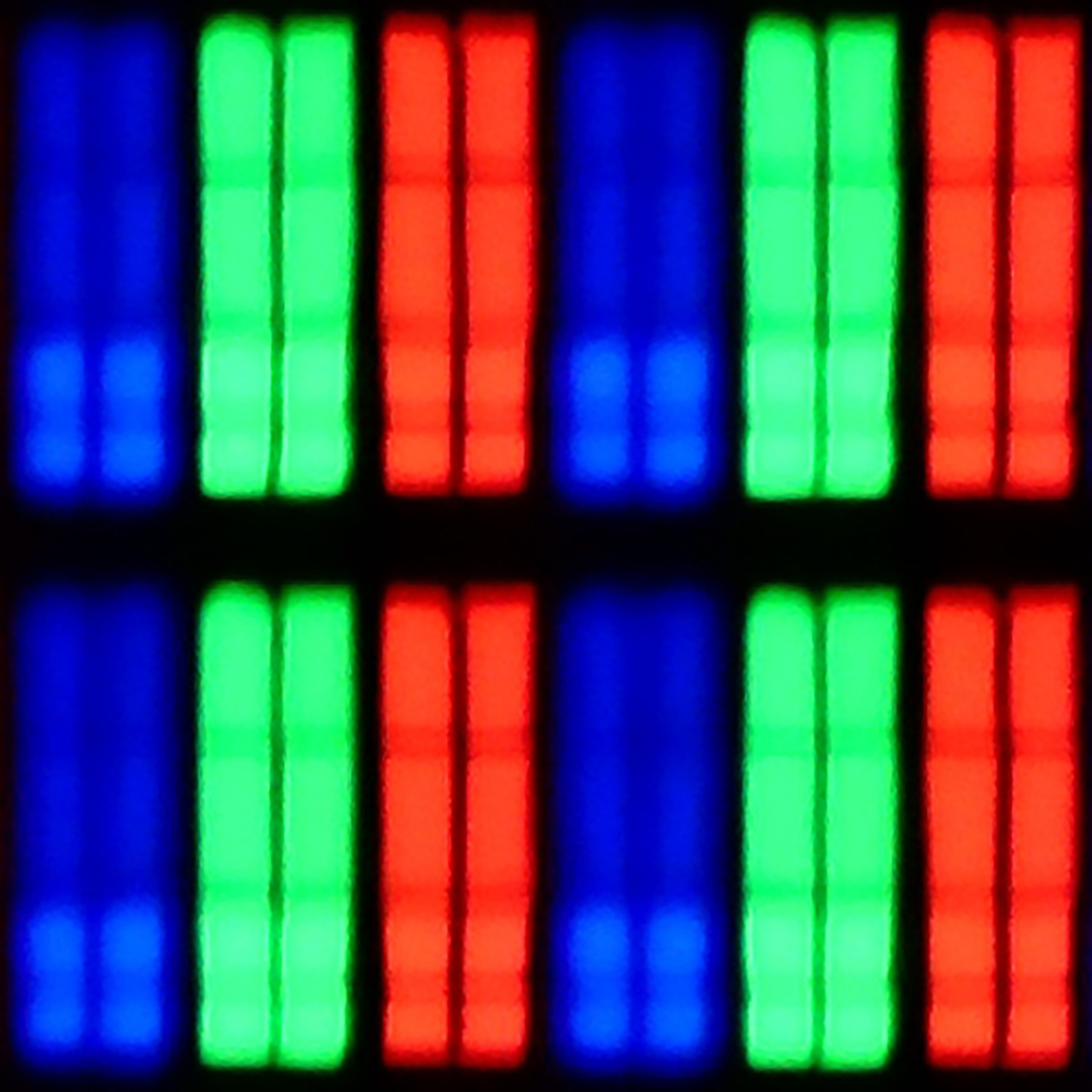
Panel uniformity:


Hisense S7NQ CanvasTV
TCL C6K
TV features
9/10
7/10
- HDMI inputs2 x HDMI 2.0, 2 x HDMI 2.1 48Gbps2 x HDMI 2.0, 2 x HDMI 2.1 48Gbps
- OutputsToslink (Optical audio), eARC (HDMI), ARC (HDMI)Toslink (Optical audio), eARC (HDMI), ARC (HDMI)
- Network InterfacesWi-Fi 2.4GHz, Wi-Fi 5GHz, Ethernet (LAN) 100MbpsWi-Fi 2.4GHz, Wi-Fi 5GHz, Ethernet (LAN) 100Mbps
- TV receptionDVB-T, DVB-T2, DVB-S, DVB-S2, DVB-CDVB-T, DVB-T2, DVB-S, DVB-S2, DVB-C
Classic features:
- Recording to USB (terrestrial TV)
- Recording programming
- Picture in Picture (PiP)
- RF remote control (no need to aim at the screen)
- Backlit remote control
- Teletext
- Audio only mode
- Possibility to connect Bluetooth headphones to the TV
- Possibility to simultaneously use Bluetooth headphones and the TV speaker
Smart features:
- AirPlay
- Screen mirroring (Windows Miracast)
- Wyszukiwanie głosowe
- Voice search in native language
- Ability to connect a keyboard and mouse




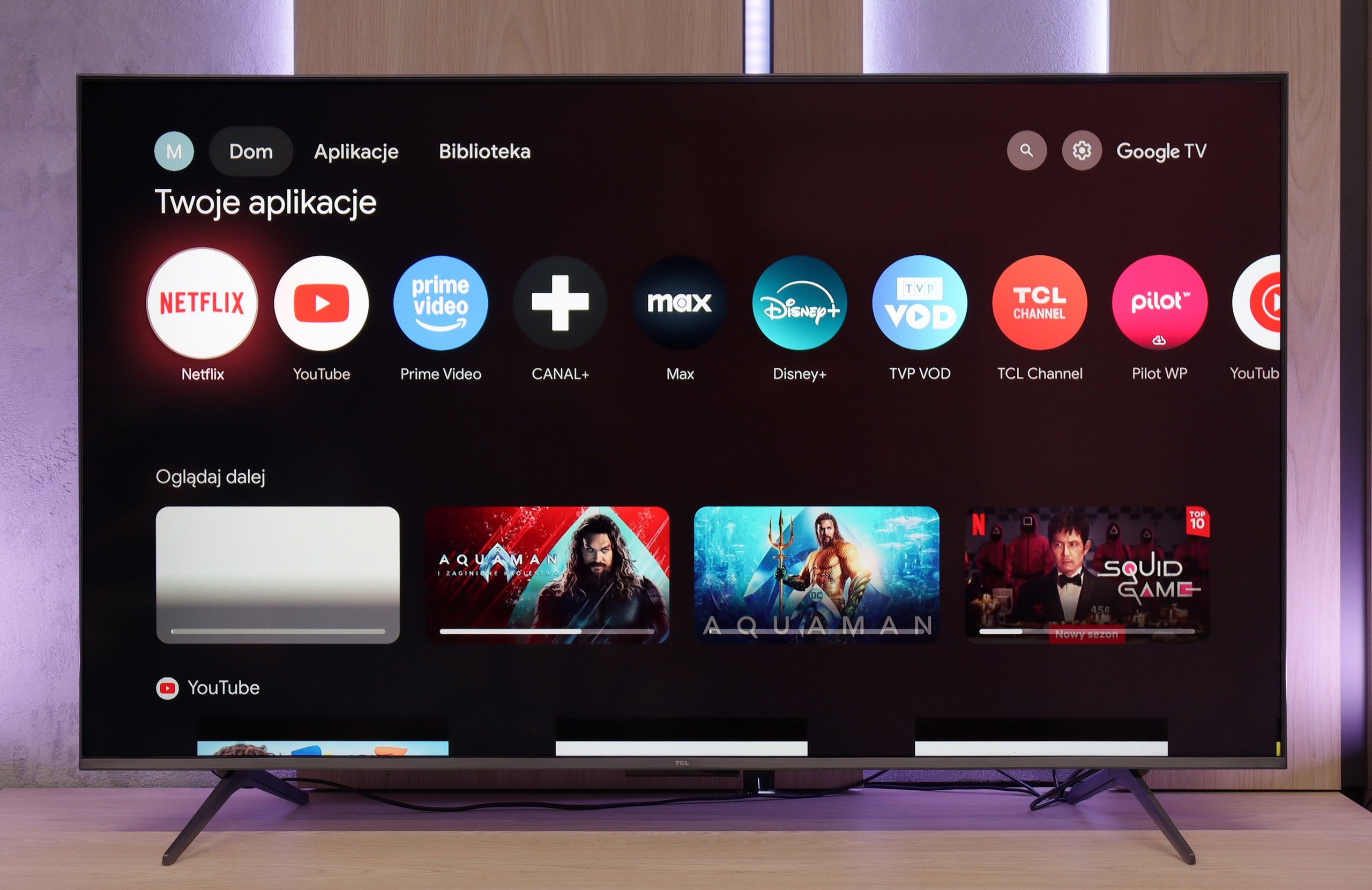
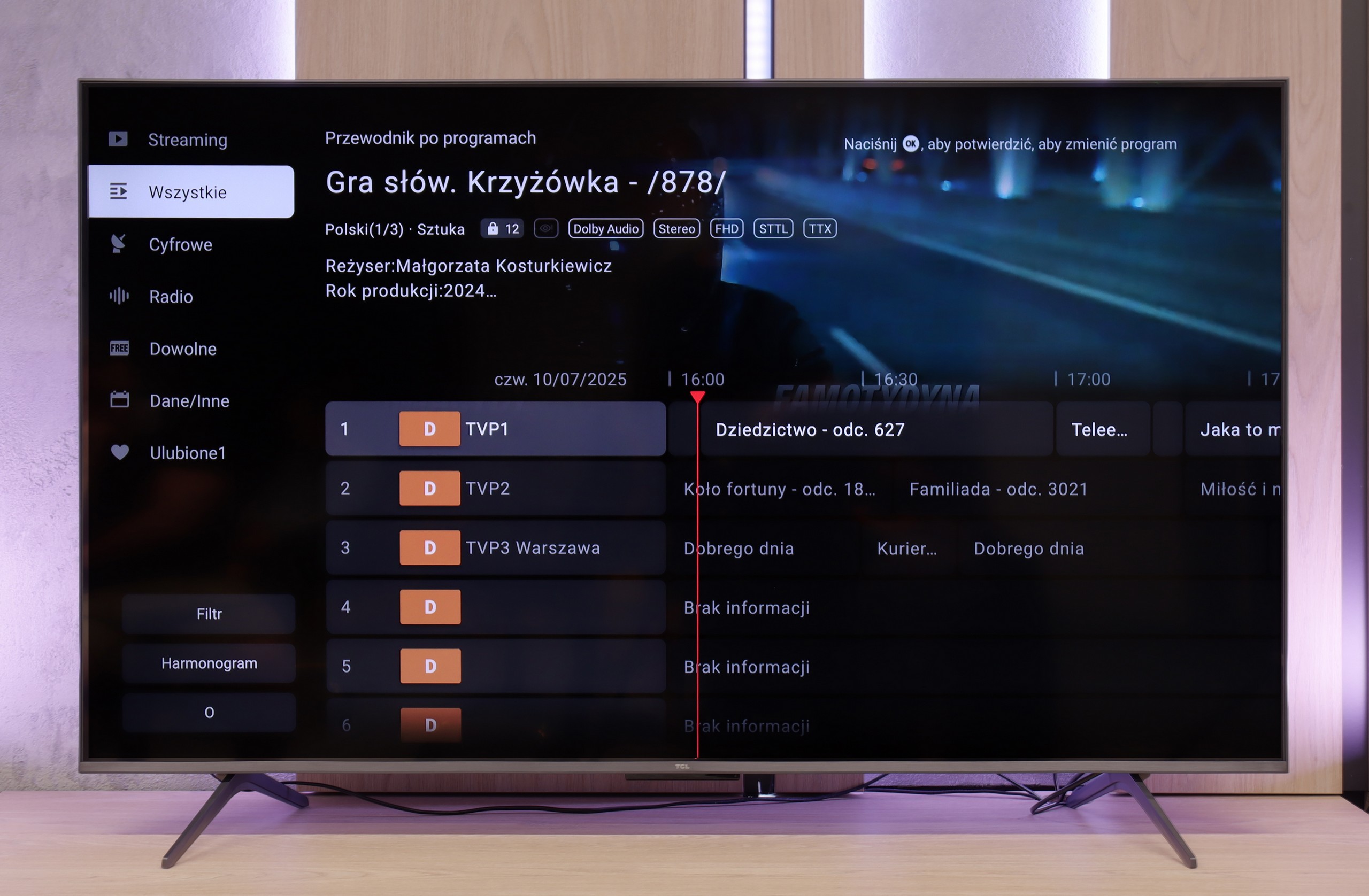
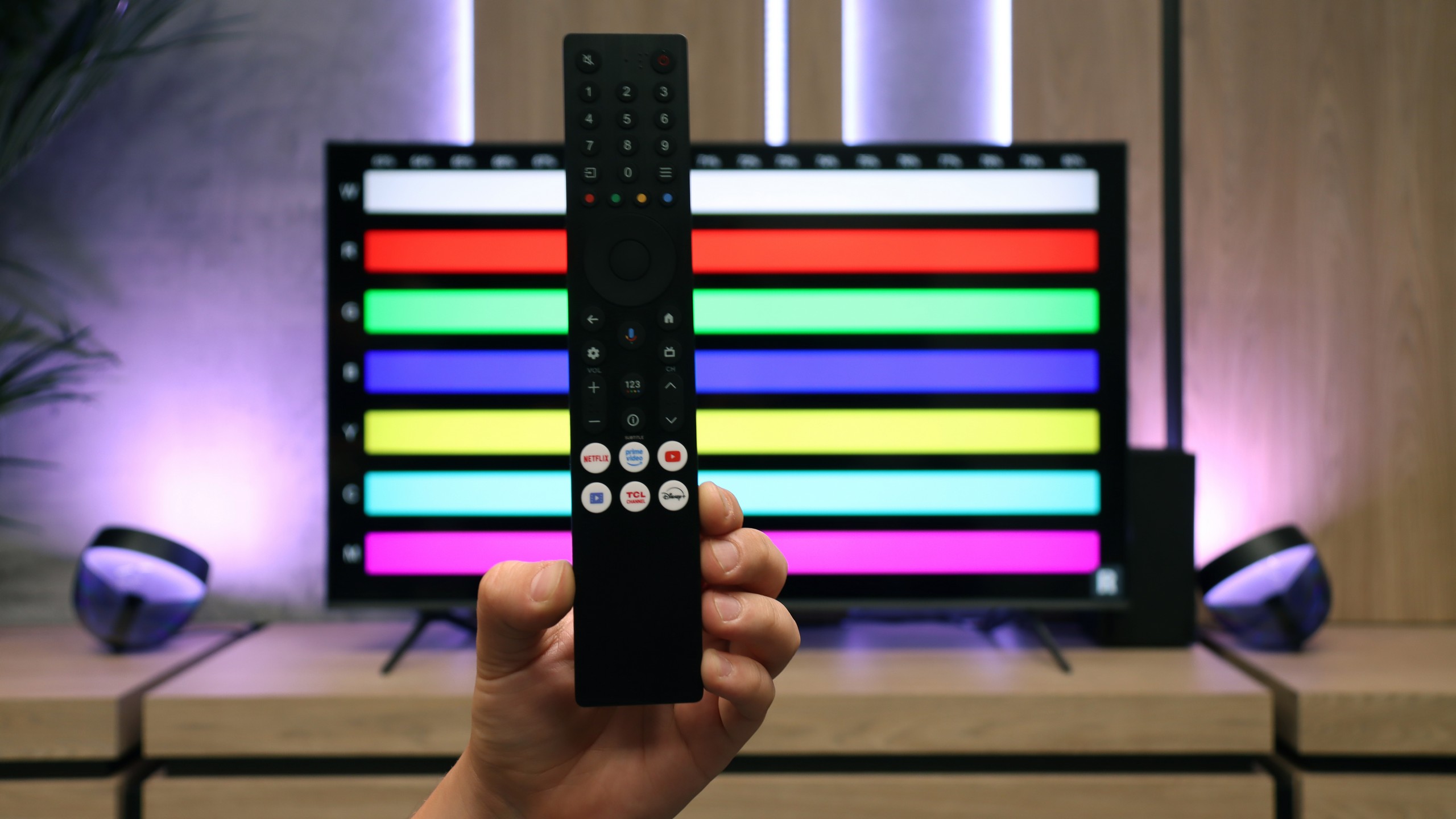
As the Hisense S7NQ is a dedicated television, we'll start the description a bit differently – from the most important aspect of this type of model, which is displaying works of art. Like all "art" televisions, it features a special mount that allows for the screen to be installed completely flat. The biggest advantage over the Korean Samsung The Frame is the fact that despite fewer artworks available in gallery mode, all of them are completely free – there’s no subscription fee required. An additional bonus that comes with the S7NQ is the light brown frame. This is a significant plus, especially if someone was already planning to choose that colour – you can save a bit of money on both the frame and the subscription.
However, when it comes to the quality of the displayed images, it’s clear that Samsung The Frame significantly outperforms here. In the S7NQ, the images look more digital, whereas in The Frame, the Art Store mode offers true scans of artworks, showing even the texture of the paint or the brush strokes of the artist. And once again, we return to the old truth – for better quality, you simply have to pay.
Fortunately, the S7NQ is not just an "art piece", but also a normal television – and in this role, it performs really well. Like most Hisense models with the VIDAA system, it offers many basic functions such as USB recording, screen mirroring, and AirPlay support. As for apps – the most popular streaming services are present here, and you can find their complete list below.
Multimedia Features: Google TV
The standout feature of the TCL C6K is undoubtedly the Google TV system. It gives the television its character and gives it an edge over many competitors. We have a full suite of services – from support for popular streaming apps, through screen mirroring support, to AirPlay, so iPhone users will feel right at home. Additionally, there's Google Assistant (now in the Gemini AI version), which not only answers questions but also efficiently carries out simple commands like changing channels or searching for content on VOD services. The system itself operates quite responsively, although it’s hard not to mention a certain drawback – the clumsy translations in the Polish menu can elicit a smile but sometimes require a moment of thought to decipher what’s really meant.
Classic Features
When it comes to classic television features, the TCL C6K is rather average. We won’t find USB recording or PiP mode, which may be disappointing for some. However, the manufacturer hasn’t forgotten the basics – teletext television and a clear EPG are available, which still hold significance for some users. In everyday use, support for external audio devices via Bluetooth comes in handy – a straightforward way to connect a speaker or headphones, which could be a practical solution for seniors. Beyond that, it’s hard to spot elements that would distinguish the C6K from its competitors – it’s simply a solid, but standard package of basic features.
Playing files from USB
5.4/10
8.9/10
Supported photo formats:
Maximum photo resolution:

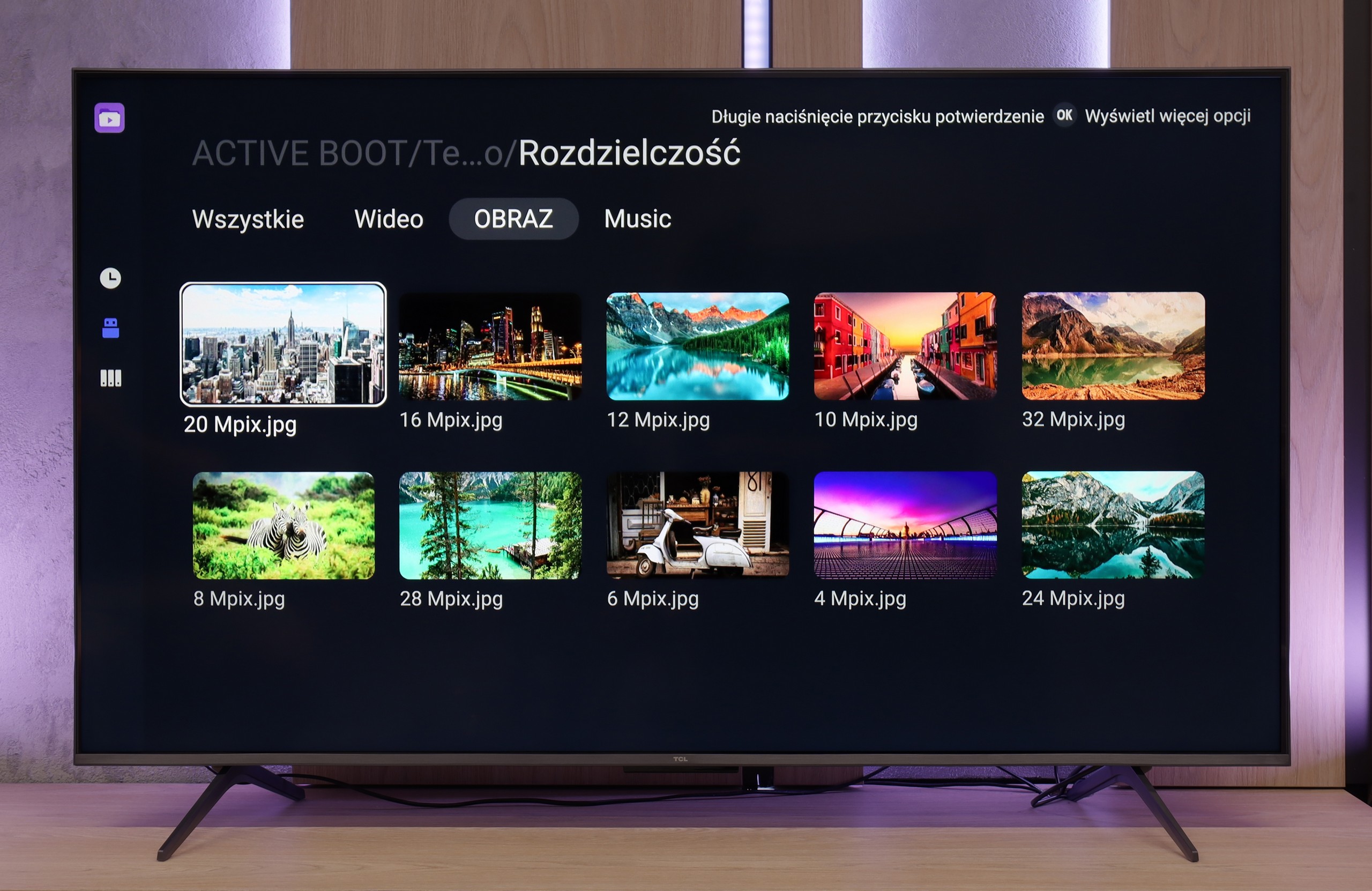
Hisense S7NQ has no trouble playing the vast majority of popular audio, photo, and video formats. So why is the rating in this category relatively low? Well, it's because of software issues. This is another Hisense television that didn't allow us to open external subtitles in movies. Regardless of whether we're talking about the .ass, .srt, .txt, or .sub format – the subtitles simply didn't appear.
The funniest (or rather the most frustrating) part about all this is that in the menu we can find options to change the font colour, size, and background… The problem is, the subtitles themselves are not visible at all.
The built-in media player in the TCL C6K performs really well – practically all popular file formats work without major issues. There are minor exceptions, particularly with less common codecs or unusual video file configurations, but in everyday use, this rarely becomes noticeable. The biggest plus, however, is that the television runs on Google TV, which offers complete freedom in choosing additional software. If someone encounters a file that the standard player can't handle, all they need to do is install an alternative – like VLC – and the problem disappears.
Apps
7.7/10
9.6/10














































Sound
6.3/10
6.5/10
- Subjective sound quality:6.3/106.5/10
- Dolby Digital Plus 7.1:
- Dolby True HD 7.1:
- Dolby Atmos in Dolby Digital Plus (JOC):
- Dolby Atmos in Dolby True HD:
- DTS:X in DTS-HD MA:
- DTS-HD Master Audio:
When it comes to sound, it presents itself... just like a television on the wall – rather flat. Despite the use of a 2.0.2 speaker setup with a total power of 36 W, we can't speak of any exceptional sound quality here. But as is often the case – buying even the simplest soundbar can dramatically change the situation.
On the plus side, it does support virtually all popular Dolby and DTS codecs. This means we can easily connect the television to a home theatre system without having to fiddle with settings or audio conversion.
In terms of audio, the TCL C6K performs quite well. The manufacturer has been boasting about its collaboration with the Onkyo brand for several years, and it indeed reflects on the sound quality. The sound is pleasant, with clear mid-tones and fairly crisp highs, and overall, it gives the impression of being well-balanced. Of course, it won't replace a proper soundbar, especially regarding bass depth, but for built-in speakers in a TV from this price segment – it’s really quite good.


